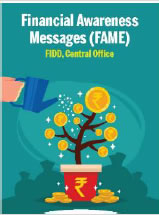 IST,
IST,
Monetary and Credit Information Review
Special Liquidity Scheme for NBFCs/HFCs The Reserve Bank on July 01, 2020 advised all Non Banking Financial Companies (NBFCs) and Housing Finance Companies (HFCs) to meet the following conditions to become eligible under the Special Liquidity Scheme for NBFCs/HFCs approved by the Government of India: i) NBFCs including Microfinance Institutions that are registered with the RBI under the Reserve Bank of India Act, 1934, excluding those registered as Core Investment Companies; ii) Housing Finance Companies that are registered under the National Housing Bank Act, 1987; iii) Capital to Risk Assets Ratio (CRAR)/Capital Adequacy Ratio (CAR) of NBFCs/HFCs should not be below the regulatory minimum, i.e., 15 per cent and 12 per cent respectively as on March 31, 2019; iv) The net non-performing assets should not be more than 6 per cent as on March 31, 2019; v) They should have made net profit in at least one of the last two preceding financial years (i.e. 2017-18 and 2018-19); vi) They should not have been reported under SMA-1 or SMA-2 category by any bank for their borrowings during last one year prior to August 01, 2018; vii) They should be rated investment grade by a SEBI registered rating agency; viii) They should comply with the requirement of the SPV for an appropriate level of collateral from the entity, which, however, would be optional and to be decided by the SPV. The Government of India had approved the scheme to improve the liquidity position of NBFCs/HFCs through a Special Purpose Vehicle (SPV) to avoid any potential systemic risks to the financial sector. To read more, please click here. Stressed MSMEs - Distressed Assets Fund The Reserve Bank on July 01, 2020 permitted all scheduled commercial banks including regional rural banks to reckon the funds infused by the promoters in their MSME units through loans availed under the scheme as equity/quasi equity from the promoters for debt-equity computation. Since the credit facilities extended under the scheme are backed by a guarantee from CGTMSE, the Reserve Bank took this decision as a special dispensation. To read more, please click here. Extension of Timeline for Finalisation of Audited Accounts The Reserve Bank on July 06, 2020 extended the timeline for finalisation of audited accounts, in view of the on-going situation and taking into account the feedback received from various stakeholders. Accordingly, every applicable NBFC shall finalise its balance sheet within a period of three months from the date to which it pertains or any date as notified by SEBI for submission of financial results by listed entities. To read more, please click here. Fair Practices Code for ARCs The Reserve Bank on July 16, 2020 advised all Asset Reconstruction Companies (ARCs) registered with the Reserve Bank to adopt ‘Fair Practices Code’ (FPC) to ensure transparency and fairness in their dealing with stakeholders. The FPC for ARCs provide the minimum regulatory expectation while each ARC’s board is free to enhance its scope and coverage. The FPC must be followed in right earnest and the board must involve itself in its evolution and proper implementation at all times. The FPC has been placed in public domain on the Reserve Bank’s website for information of all stakeholders and can be accessed by clicking here. Implementation of IndAS The Reserve Bank on July 24, 2020 decided that the unrealised gain/loss on a derivative transaction undertaken for hedging may be offset against the unrealised loss/gain recognised in the capital (either through profit or loss or through other comprehensive income) on the corresponding underlying hedged instrument. If after such offset and netting with unrealised gains/losses on other financial instruments, there are still net unrealised gains, the same should be excluded from regulatory capital as per the Reserve Bank’s circular dated March 13, 2020 on Implementation of Indian Accounting Standards (IndAS). To read more, please click here. II. Payment and Settlement Systems Committee for Analysis of QR Code The Reserve Bank on July 22, 2020 placed on its website the report of the ‘Committee for Analysis of Quick Response (QR) code’ constituted under the chairmanship of Prof. D.B. Pathak to review the prevalent system of QR codes in India. The Reserve Bank had constituted the committee on December 23, 2019 for facilitating digital payments in the country. The report has been placed on the Reserve Bank’s website for comments/suggestions from all stakeholders and members of public which may be forwarded on or before August 10, 2020. To read more, please click here. Indian Stamp Act, 1899 Amended The Reserve Bank in its Press Release dated July 01, 2020 conveyed that Clearing Corporation of India Ltd. has been appointed as collecting agent for foreign exchange, interest rate and credit derivative transactions which are reported to it with effect from July 01, 2020. The Government of India, amended the Indian Stamp Act 1899 (revised Act), through Finance Act, 2019, and the relevant Stamp Rules, 2019. The Government also released a set FAQs on the revised Act. To read more, please click here. National Strategy for Financial Education
Credit Flow to MSME Sector The Reserve Bank on July 02, 2020 conveyed to all commercial banks, primary urban co-operative banks/state co-operative banks/district central cooperative banks, financial institutions and NBFCs the new criteria for classifying enterprises as Micro, Small and Medium Enterprises (MSMEs). The criteria laid down by the Government of India for such classification is as follows: i) Classification of Enterprises A micro enterprise, where the investment in plant and machinery or equipment does not exceed one crore rupees and turnover does not exceed five crore rupees; small enterprise, where the investment in plant and machinery or equipment does not exceed ten crore rupees and turnover does not exceed fifty crore rupees; and medium enterprise, where the investment in plant and machinery or equipment does not exceed fifty crore rupees and turnover does not exceed two hundred and fifty crore rupees shall be classified as a MSME. ii) Composite criteria of investment and turnover for classification A composite criterion of investment and turnover shall apply for classification of an enterprise as micro, small or medium. If an enterprise crosses the ceiling limits specified for its present category in either of the two criteria of investment or turnover, it will cease to exist in that category and be placed in the next higher category but no enterprise shall be placed in the lower category unless it goes below the ceiling limits specified for its present category in both the criteria of investment as well as turnover. iii) Calculation of investment in plant and machinery or equipment The Government of India has also laid out detailed criteria for calculation of investment in plant and machinery or equipment which will be linked to the Income Tax Return (ITR) of the previous years filed under the Income Tax Act, 1961. iv) Calculation of Turnover Exports of goods or services or both, shall be excluded while calculating the turnover of any enterprise whether micro, small or medium, for the purposes of classification. Information as regards turnover and exports turnover for an enterprise shall be linked to the Income Tax Act or the Central Goods and Services Act (CGST Act) and the GSTIN. The Government of India, on June 26, 2020, notified new criteria for classifying the enterprises as MSMEs with effect from July 01, 2020. To read more, please click here. Sectoral Deployment of Bank Credit The Reserve Bank on July 31, 2020 placed on its website the data on sectoral deployment of bank credit collected from select 33 scheduled commercial banks for the month of June 2020. On a year-on-year (y-o-y) basis, non-food bank credit growth at 6.7 per cent in June 2020 was nearly the same as in May 2020 but lower than the growth of 11.1 per cent in June 2019. Credit growth to agriculture and allied activities increased by 2.4 per cent in June 2020 as compared with a higher growth of 8.7 per cent in June 2019. To read more, please click here.
Outstanding Credit of SCBs The Reserve Bank on July 15, 2020 released its web publication entitled ‘Quarterly Basic Statistical Returns (BSR)-1:Outstanding Credit of Scheduled Commercial Banks (SCBs), March 2020’, on its Database on Indian Economy (DBIE) portal. As per the major highlights of the publication, bank credit growth (Y-o-Y) continued to decelerate across all population groups and stood at 6.3 per cent in March 2020; bank branches in rural areas, however, maintained double digit growth. The share of industrial credit in total bank credit declined to 31.5 per cent in March 2020 (33.1 per cent a year ago), as it recorded a meagre 0.9 per cent growth (Y-o-Y) in March 2020. Overall credit expansion has been supported by a robust growth in personal loans in the recent period. To read the full publication, please click here. Performance of NGNBF&I The Reserve Bank on July 24, 2020 placed on its website the data relating to the performance of non-government non-banking financial and investment (NGNBF&I) companies excluding insurance and banking companies for the year 2018-19. As per the data release, financial income recorded a robust growth of 21.9 per cent (Y-o-Y) in 2018-19 on the back of increased lending and investments activities. Combined balance sheet of the NGNBF&I companies expanded by 17.6 per cent during 2018-19 over and above 24.5 per cent increase in the previous year: asset finance companies had the largest share of 45.5 per cent. To read more, please click here. RBI-Occasional Papers The Reserve Bank on July 16, 2020 released Volume 41, No.1 of its Occasional Papers, a research journal containing contributions from RBI’s staff members. This issue contains three articles and two book reviews. Articles: Modelling and Forecasting Currency Demand in India: A Heterodox Approach: In this article, Dr. Janak Raj, Shri Indranil Bhattacharyya, Samir Ranjan Behera, Joice John and Bhimappa Arjun Talwar use several time series and econometric techniques to forecast and analyse currency demand in India. To read the full article, please click here. Pass-through of International Food Prices to Emerging Market Economies: A Revisit In this article, Shri Satyananda Sahoo, Sujeesh Kumar and Ms. Barkha Gupta re-examine the pass-through of global food prices to domestic food prices in the emerging market economies. To read the full article, please click here. Trends and Dynamics of Productivity in India: Sectoral Analysis In this article, Shri Sarthak Gulati, Utsav Saksena, Avdhesh Kumar Shukla, V. Dhanya and Thangzason Sonna undertake a detailed sectoral analysis of total factor productivity (TFP) using the India KLEMS database. To read the full article, please click here. RBI Working Paper Series The Reserve Bank released two publications under its working paper series in the month of July 2020. The first working paper titled “Impact of Leverage on Firms’ Investment: Decoding the Indian Experience” co-authored by Avdhesh Kumar Shukla and Tara Shankar Shaw focuses on the relationship between firms’ leverage and their investment behavior in India. The empirical results suggest that firm-level leverage could provide early signals about the movements in investment cycle. To read the full paper, please click here. The second working paper titled “Subnational Government Debt Sustainability in India: An Empirical Analysis” authored by Sangita Misra, Kirti Gupta and Pushpa Trivedi assesses the sustainability of debt for Indian states. Fiscal shocks through schemes like Ujwal DISCOM Assurance Yojana (UDAY) have led to increased fiscal pressures exacerbating the debt dynamics of states at periodic intervals. To read the full paper, please click here.
Edited and published by Yogesh Dayal for Reserve Bank of India, Department of Communication, Central Office, Shahid Bhagat Singh Marg, Mumbai - 400 001. MCIR can be also accessed at https://mcir.rbi.org.in. |



















